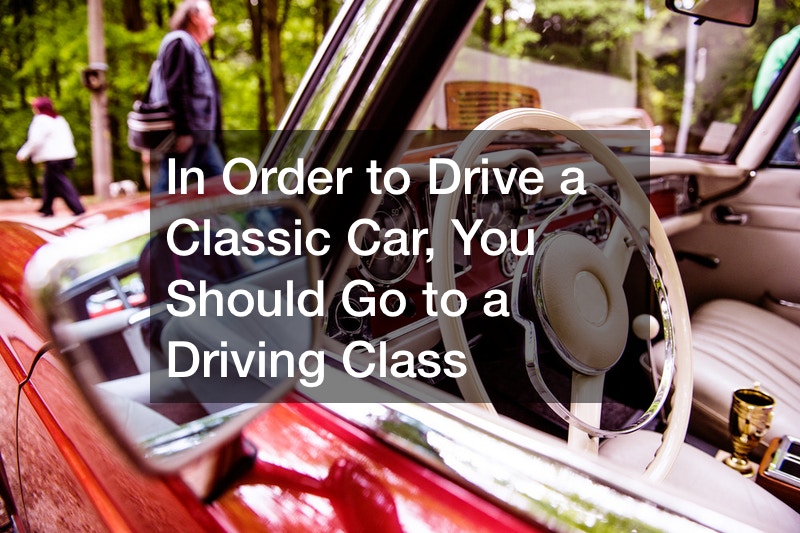
If you’re thinking about driving a classic car, make sure you know how to drive. The majority of classic cars are stick shift, and you will need to know how to use a clutch. Don’t try driving a stick if you haven’t driven one before. You will need to practice by using a friend’s car or get lessons. Practice starting in second gear and shifting through each gear until it is time to park your vehicle. It is important that you don’t stall the engine when trying to shift gears.
There are DMV driver improvement classes that you can take to learn manual transmission driving. Once you buy your car, make sure it is properly insured and registered before you go driving off into the sunset. If it doesn’t have proper insurance or registration, don’t drive it. DMV driver improvement classes can make you a better driver, and they may even help keep your insurance costs down.
The safety of all road users is extremely important. Taking classes will help you learn things that you can do immediately while driving. For example, not drinking before driving could save other peoples’ lives as well as your own and save you from having to hire a DUI attorney.
In some states, driver improvement classes are available from licensed private, for-profit driving schools. In other states, the course is offered by approved non-profit organizations as a service to their members or as a public service. In some cases, the cost of the program may be partially subsidized by state funds. In other cases, the cost of the program is fully subsidized by a state agency as a public service.
Classic cars are not as technologically advanced as the ones we have today. That means you should be driving your car at a slower speed than normal, especially through residential neighborhoods. Driving too fast may damage the engine or transmission of your classic car. There are many advantages and disadvantages to driving a classic car versus a modern car.
Different Driving Styles

Classic cars and modern cars have different driving styles. In some ways, classic cars feel very similar to modern cars but in some key areas, they are completely different.
Modern cars have a lot of electronics that keep you safe and improve driving performance. For example, Antilock Breaking System (ABS) is a vital part of driving a car today, it stops the wheels from locking up under heavy braking which can help avoid skids. Electronic Stability Control helps keep the car balanced and reduces accidents. Traction Control helps stop wheel spin under acceleration and improves grip on slippery surfaces like snow and rain. Dynamic Stability Control is an extension of classic ABS that keeps the car from spinning out of control by reducing engine power when sensors detect a skid.
These safety features mean that modern cars can be driven faster and taken to places that aren’t possible with older cars. Modern cars have fewer moving parts and are easier to maintain as a result. To start a classic car, you need to manually turn the engine over until it starts. In comparison, modern engines only need to be started once then they’re ready to go. This is another reason why modern cars are more efficient. They can rev higher because there’s no need to turn the engine over again.
Modern brakes are much different as well. Most classic cars have drum brakes in the rear and disc brakes in front. Drum brakes are powerful but take longer to stop the car, especially when wet or icy. Drum brakes also place the majority of the braking force on one side, which can cause the car to drift out of control.
Modern cars have disc brakes on all four wheels and they’re more powerful than drums. They can stop much faster and maintain stability in most conditions, including snow or ice.
Today, classic cars are used as a hobby and they’re typically driven only on nice days. Modern cars have so many safety features that it makes them great for everyday driving in any condition including rain, snow, or ice.
Modern cars also have much more power because of turbochargers and fuel injection, which give faster acceleration and better fuel economy. The majority of modern cars are front-wheel drive instead of rear-wheel like classic cars. This makes them easier to control under heavy acceleration or during cornering.
However, there is one significant downside to modern cars, and that’s the design. Modern cars are designed to be safer with crumple zones and airbags everywhere. This means modern cars tend to be bigger and heavier than older cars which reduces fuel efficiency, power, and performance.
Classic cars are great for a Sunday drive on a warm summer day without AC needed, but modern cars have so many safety features and more power that they are in fact much better for everyday driving.
Classic Cars Require More Maintenance
Driving a classic car can be more challenging and fun than driving a modern car. Although all cars may seem virtually the same alongside their modern counterparts, classic cars have their own unique traits which may make them difficult to drive. These are usually due to age and mechanical wear and tear or lack thereof. There’s nothing like driving a 1966 Jaguar E-Type Roadster with a 4.2L engine. It can be both exhilarating and terrifying, even though its powertrain is similar to a 2012 Volkswagen Beetle Turbo.
Here are ten common issues with classic cars that you would not necessarily have with a modern car. Although most of these problems are minor when they arise, some can pose serious threats if not addressed immediately by classic car restoration services or an auto detailing company.
Electrical Issues
Battery life and water damage can drastically shorten the life and effectiveness of electrical components. Classic cars may also have older parts that require you to fix or replace, such as electronics and wiring.
Clutch Failure
There are three types of clutch failure: Mechanical (failure due to wear), Slip (failure due to heat), and Pilot bearing (failure due to age). Driving a manual car with a slipping clutch is extremely difficult, dangerous and should be addressed immediately.
Rust and Corrosion
As time goes on, metal parts begin corroding and rusting. This is because metal reacts with the air, water (from dew), salt, and acid rain over time. If ignored long enough, rust can cause severe damage to metal parts causing them to fail or break completely. Take preventative measures as soon as possible.
Tires

Classic cars require newer tires that are better suited for their heavyweight and higher top speed abilities than modern tire technology. Modern tires are designed to reduce rolling resistance, which may sacrifice durability, grip, and handling during spirited driving. Avoid punctures by visiting your local tire shop for a fresh set of rubber before you take your classic car out on the road again.
Check the tires regularly for wear or damage. This includes checking air pressure every time before you drive your classic car on the road again. Some cars from before 1980 still used solid rubber tires instead of pneumatic ones, so always check if they need replacement as well.
Brakes
Most cars manufactured today use disc brakes instead of drum brakes, making them lighter and more responsive than their vintage counterparts. Replacing old brake rotors can be much cheaper than replacing the entire system, but it is still an important thing to consider before you drive your classic car on the road again.
Suspension
Many older cars still use leaf springs as a suspension system, which are usually rusted or worn by now due to age. Others may use coil springs (some wire-type or rubber donuts), torsion bars, or even airbags designed for newer cars. Classic car suspensions must also be upgraded if you plan on taking them out for track days or any kind of motorsport.
Engine Oil Leaks
You should always check for engine oil leaks or any fluid leaks of any kind before you drive your classic car on the road again. These are especially common in antique cars made after 1950, but can also happen to modern cars if not properly maintained. Even if your engine does not have a blown head gasket, it could still be burning oil which will cause the undercarriage to gradually rust. This can also happen if there is a crack in the engine block or any other part of the engine. Brake fluid may also leak due to a faulty brake cylinder or a rusted line, so always check the level before driving again. You might need to find an oil company that specializes in oils for classic cars.
Head Gasket Failure
Although rarer than other problems, head gasket failure is something you must be aware of before turning over the ignition. This happens when the engine gets too hot while it’s being driven, causing its metal parts to warp and push away from each other, causing a blown head gasket. This usually requires an engine rebuild.
Timing Chain Failure
Some engines have timing chains instead of belts because they last longer, can handle more stress, and are less likely to slip. If you neglect the chain for too long, it could snap or crack, throwing your belt off track, which will damage other vital components in your engine.
Rust in Car Fluids
Most people forget that antifreeze (coolant), oil, brake fluid, and transmission fluid all rust over time. Around half of the cars manufactured before 1980 have some form of coolant leak due to corrosion in their metal parts or old rubber seals which need replacement.
Fuel System Problems
The most popular types of fuel systems today include electric fuel pumps and carburetors, but some cars, including classics, were manufactured with mechanical fuel pumps, such as those that run on camshafts or crankshaft. Modern cars use plastic lines and fittings instead of rubber ones that could crack and fail over time, so replacing them will usually solve any leakage problems.
Engine Compression

This is a great way to check for engine wear and tear before putting your car on the road again. Although not required in all states, it can be done by anyone with access to a compression tester (available at most auto parts stores). If the readings are low, it means there is some form of internal engine damage such as worn-out piston rings or valves that need replacement.
Car Won’t Start
Your car may have a faulty starter or a bad battery. You can find out by going to your local mechanic for a quick test. If the mechanic tells you that there is no problem, check under the hood and make sure all of your cables are properly connected and not fraying.
You’re less likely to see a classic car on the road than you are to see a modern car. Classic cars require more maintenance, as every part is exposed and easily accessible. Fortunately, there are proper tools that can help you save money on expensive repair bills. If you have a few simple tools in your garage, chances are that you can already work on your classic car without the need to visit an expert for every tiny problem. There are garage door companies that can help you protect your vintage car so you don’t have to worry about intruders. If you’re really serious about maintaining the condition of your classic car, you could hire paving contractors or pavers and excavators to create an environment for your old cars to minimize wear and tear. With the right information and funds, you can maintain your car in the right way.


